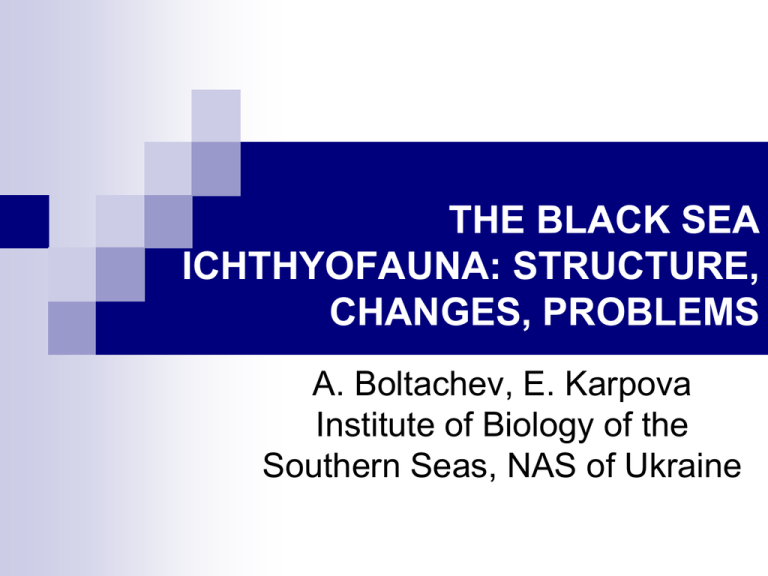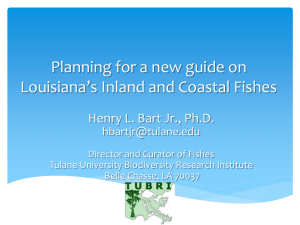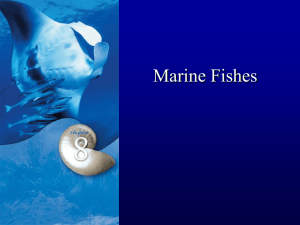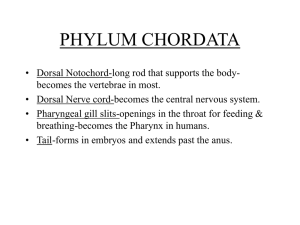The Black Sea Ichthyofauna: Structure, Changes, Problems
advertisement

THE BLACK SEA ICHTHYOFAUNA: STRUCTURE, CHANGES, PROBLEMS A. Boltachev, E. Karpova Institute of Biology of the Southern Seas, NAS of Ukraine Black Sea Considerable isolation of the Black Sea from the World Ocean, specificity of the habitat environment hydrologo-hydrochemical conditions, heavy geological past and contemporary anthropogenic pressure affected fundamentally the processes in the unique ichthyofauna formation and changing. Black Sea According to recent data, obtained as a result of successful cooperation of expert-ichthyologists of the BSC from all the Black Sea countries the Black Sea ichthyofauna numbers 234 fish species and subspecies, which are attributed to 68 families. We would like to express our deep gratitude to Maria Yankova, Violeta Velikova, Valeria Abaza and all colleagues for cooperation in creating the ”Black Sea Fish Check-List”. Ichthyofauna Idea of the genesis of the Black Sea ichthyofauna was first developed by K. F. Kessler (1877), his basic assumption was the presence of two components of groups: 1) ancient autochthonous species originated from a diverse and numerous relict fish that had no similar forms in other marine basins 2) allochthonous species, whose formation is directly related to the last joint of the Black Sea with the Mediterranean and active processes of the fish mass immigrations from the Mediterranean Sea. Mesogobius barachocephalus Aidablennius sphinx In addition to these two groups, V.K. Sovinsky (1904) has allocated the third ones - the "new autochthonous", which included a fully naturalized Mediterranean immigrants in to the Black Sea and formed a species (Syngnathus schmidti) or subspecies (Trachurus mediterraneus ponticus, Merlangius merlangus euxinus, Belone belone euxini), totally about 60 species and Syngnathus schmidti subspecies. Ichthyofauna This is an important moment of the contemporary Black Sea ichthyofauna formation. At the present time, the fact of taxonomical isolation of the Black Sea subspecies is not adopted by the number of ichthyologists and they attribute them to those previously excepted Atlantic-Mediterranean Sea species. The other ichthyologists consider that the majority of the Black Sea fish subspecies are valid species. We think that it is necessary to conduct taxonomic revision of the Black Sea ichthyofauna, using morphometric and genetic methods. Working out, implementation and financing of such international program under the aegis of the Black Sea Commission are quite actual. These investigations are not only of theoretic but of practical importance as well for preservation and rational usage of separate Black Sea fish species. Ichthyofauna Ichthyofauna of the Black Sea includes fishes, very different by their genesis, ecological and faunistic complexes; they should be united in 4 main groups: marine – 146 species (62,4%), diadromous – 17 (7,3%), brackish water ponto-caspian endemics – 20 (8,5%) and fresh water, including semi-diadromous – 51 (21,8%) fishes. 62.4% 21.8% 8.5% - 7.3% marine diadromous brackishwater ponto-caspian endemics freshwater (including semi-diadromous) Marine fishes Species, inhabiting the Mediterranean-Atlantic basin mainly (142 species) are prevailing among the marine fishes, but some of them are widespread more in the World Ocean. Two subgroups can be isolated by their origin – thermophilic tropical, subtropical and psychrophilic boreal Atlantic species. Over 90% of Mediterranean immigrants are thermophilic tropical and subtropical species. 0 20 40 60 AtlanticMediterranean 80 100 120 140 160 Boreal Atlantic Indo-Pacific Less than 10% are cold-boreal-Atlantic species. According to well-known ichthyologist T.S. Russ occupancy by boreal species occurred in the early Holocene, thermophilic much later - less than 8 thousand years ago. On this basis he has allocated a group of "Boreal-Atlantic relict fish." This hypothesis has been subjected to sharp criticism from V.A. Vodyanitsky, who believed that the species included in it are the Mediterranean immigrants of boreal origin, and invasion by psychrophilic – and thermophilic fish happened at the same time and use of the term "Boreal-Atlantic relicts" is not correct. We support this view of V.A. Vodyanitsky. Subgroup of marine fishes from distant areas of the World Ocean is new to the Black Sea. Marine fishes The appearance of this last subgroup of marine fishes in the Black Sea is connected with the anthropogenic activities (4 species). Liza haematocheila, possibly being naturalized in the Azov-Black Sea basin completely Tridentiger trigonocephalus, invaded the Sevastopol bay as a result of occasional discharge from aquarium or with ballast waters Indo-Pacific red barracuda (Sphyraena pinguis) moved in through the Suez Canal in the eastern Mediterranean (Lesseps migrant), which to date has achieved a high number, and could easily penetrate through the straits into the Black Sea, down to the south-west coast of the Crimea. Extension of its migration to the Black Sea during the warm season is possible. The appearance in the Balaklava Bay of exotic Indo-Pacific coral fish Heniochus acuminatus obviously is associated with ballast water and is accidental. Brackish water ponto-caspian endemic fishes Group of brackish water ponto-caspian endemics, which includes representatives of 7 autochthonic genera from the family Gobiidae and some other (for example, Clupeonella cultriventris, Pungitius platygaster and Percarina demidoffi) is unique. According to the opinion of some researchers, formation of the brackish water group as well as of diadromous herrings of the genus Alosa from the initially marine species occurred in Miocene as far as Sarmatic Sea (existed from 7(5) to 3 (2) mln. years ago) was becoming more and more freshwater and they should be called Sarmatian relicts. According to another version, the previously mentioned ancient autochthonic complex, including diadromous Acipenseridae appeared later – in Pliocene, when 2 (1,5) – 1 mln. years ago, at the place of the salt Maeotic Sea appeared almost fresh water Pontian Lake-Sea, and because of it, they are called Pontian or Ponto-Caspian relicts. Knipowitschia caucasica Pungitius platygaster Bentophiloides brauneri Diadromous fishes Anguilla anguilla Alosa immaculata Sander marinus Populations of the most diadromous species (Acipenseridae, Salmonidae) are in the critical state, which is connected with their over-catch, spawning places destroy in rivers and damming the ways of spawning migrations. Acipenser gueldenshtadtii Acipenser stellatus Salmo labrax Huso huso Freshwater fishes The fresh water fish group, by the opinion of the most investigators, beginning with P.S.Pallas, is one of basic components of the Black Sea ichthyofauna. But there is an opposite opinion, according to which they must be excluded from the general list of the Black Sea ichthyofauna. We think, it is not correct, because fresh water fish can be noticed more or less constantly in the estuary and before-estuary zones and the region of the near - Kerch strait. Alburnus alburnus and Scardinius erythrophthalmus - common inhabitants of the Gulf Karkinitsky in the Black Sea Gambusia holbrooki in the estuary in the Bay of Sevastopol Carassius gibelio in large quantities are in estuaries, lagoons, north-western part of Black Sea, off the coast of eastern Crimea, and other parts. Semi-diadromous Abramis brama and Stizostedion lucioperca present in the catches of fishermen Conclusion What changes of the Black Sea ichthyofauna structure can be predicted in the future? Increase of the marine fish share at the expense of the continuing process of Mediterranization, occasional invasion of the small ecologically plastic species with the ballast waters or inhabiting among fouling hydrobionts on the underwater parts of the vessels is mostly probable. Decrease of the species diversity of the valuable diadromous and semidiadromous fish occurs as a result of the considerable worsening of the habitat conditions in the rivers. Besides, traditional migrations of the pelagic and large species firstly through Bosporus at the present time is problematic, which is connected with the very active Turkish fishery, great acoustical pressure as a result of intensive navigation and high degree of the strait waters contamination by industrialdomestic discharge. Thank you for attention!









